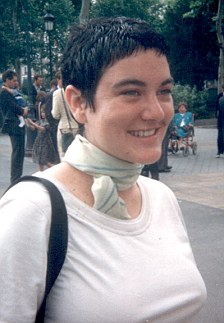Myalgic encephalomyelitis: Difference between revisions
(→Potential causes: author links) |
Notjusttired (talk | contribs) m (link fix) |
||
| (One intermediate revision by one other user not shown) | |||
| Line 82: | Line 82: | ||
[[File:Alem Matthee.png|200px|thumb|right|[[Alem Matthees]] is an [[Australia|Australian]] ME patient that filed an FOI request for data from the [[PACE trial]]. At a [[Severe and very severe ME|great cost to his health]], Alem appealed the denial of the data and won. This data proved the results published in [[The Lancet|''The Lancet'']] were untrue. Alem's health suffered significantly in part from the efforts required for the FOI request and tribunal]] | [[File:Alem Matthee.png|200px|thumb|right|[[Alem Matthees]] is an [[Australia|Australian]] ME patient that filed an FOI request for data from the [[PACE trial]]. At a [[Severe and very severe ME|great cost to his health]], Alem appealed the denial of the data and won. This data proved the results published in [[The Lancet|''The Lancet'']] were untrue. Alem's health suffered significantly in part from the efforts required for the FOI request and tribunal]] | ||
Although there is no definitive [[biomarker]], several signs and findings have been frequently observed in clinical settings:<div style="column-count:2;-moz-column-count:2;-webkit-column-count:2"> | Although there is no definitive [[biomarker]], several signs and findings have been frequently observed in clinical settings:<div style="column-count:2;-moz-column-count:2;-webkit-column-count:2"> | ||
*high [[antibody]] titers to specific infections (including [[Epstein-Barr virus|EBV]],<ref>{{Cite journal|last=Schmaling|first=K. B.|last2=Jones|first2=J. F.|date=Jan 1996|title=MMPI profiles of patients with chronic fatigue syndrome|url=https://www.ncbi.nlm.nih.gov/pubmed/8730646|journal=Journal of Psychosomatic Research|volume=40|issue=1|pages=67–74|issn=0022-3999|pmid=8730646}}</ref> [[Human herpesvirus 6|HHV-6]],<ref>http://www.ncbi.nlm.nih.gov/pubmed/9453750</ref><ref>https://www.ncbi.nlm.nih.gov/pubmed/17276367</ref>and [[Coxsackie B virus|Coxsackie B]]<ref>{{Cite journal|last=Landay|first=AL|date=September 1991|title=Chronic fatigue syndrome: clinical condition associated with immune activation|url=https://www.ncbi.nlm.nih.gov/pubmed/1679864|journal=Lancet|volume=|pages=|via=}}</ref><ref name=":03">{{Cite journal|last=Chia|first=John|date=November 2005|title=The role of enterovirus in chronic fatigue syndrome|url=https://www.ncbi.nlm.nih.gov/pmc/articles/PMC1770761/|journal=Journal of Clinical Pathology|volume=|pages=|via=}}</ref> among others) | *high [[:Category:Antibodies|antibody]] titers to specific infections (including [[Epstein-Barr virus|EBV]],<ref>{{Cite journal|last=Schmaling|first=K. B.|last2=Jones|first2=J. F.|date=Jan 1996|title=MMPI profiles of patients with chronic fatigue syndrome|url=https://www.ncbi.nlm.nih.gov/pubmed/8730646|journal=Journal of Psychosomatic Research|volume=40|issue=1|pages=67–74|issn=0022-3999|pmid=8730646}}</ref> [[Human herpesvirus 6|HHV-6]],<ref>http://www.ncbi.nlm.nih.gov/pubmed/9453750</ref><ref>https://www.ncbi.nlm.nih.gov/pubmed/17276367</ref>and [[Coxsackie B virus|Coxsackie B]]<ref>{{Cite journal|last=Landay|first=AL|date=September 1991|title=Chronic fatigue syndrome: clinical condition associated with immune activation|url=https://www.ncbi.nlm.nih.gov/pubmed/1679864|journal=Lancet|volume=|pages=|via=}}</ref><ref name=":03">{{Cite journal|last=Chia|first=John|date=November 2005|title=The role of enterovirus in chronic fatigue syndrome|url=https://www.ncbi.nlm.nih.gov/pmc/articles/PMC1770761/|journal=Journal of Clinical Pathology|volume=|pages=|via=}}</ref> among others) | ||
*[[Hormones|hormone]] imbalance<ref name="Ruiz-Núñez, 2018">{{Citation | *[[Hormones|hormone]] imbalance<ref name="Ruiz-Núñez, 2018">{{Citation | ||
| last1 = Ruiz-Núñez | first1 = Begoña | authorlink1 = | | last1 = Ruiz-Núñez | first1 = Begoña | authorlink1 = | ||
| Line 315: | Line 315: | ||
== References == | == References == | ||
{{reflist}} | |||
[[Category:Diagnoses]] | [[Category:Diagnoses]] | ||
[[Category:Disease names]] | [[Category:Disease names]] | ||
[[Category:Neurological disorders]] | [[Category:Neurological diseases and disorders]] | ||
Revision as of 01:54, October 10, 2019
Myalgic encephalomyelitis (ME) is a chronic, inflammatory, physically and neurologically disabling immune mediated disease that presents with symptoms involving multiple bodily systems. It is frequently triggered by a viral infection or a flu-like illness.[1] ME presents with symptoms in the central nervous system (CNS), autonomic nervous system (ANS), immune system, cardiovascular system, endocrine system, digestive system, and musculoskeletal system.[2][3] It is classified by the World Health Organization (WHO) as a neurological disease in 1969.[4]
ME has occurred in both epidemic and sporadic forms.
A hallmark symptom of ME is post-exertional malaise (PEM), which is an intolerance to previously achievable cognitive or physical exertion.[5][6][7][8][9][10] Other key symptoms include muscle weakness and easy fatiguability, sleep disturbance, and cognitive dysfunction. ANS dysfunction is frequent, although specific symptoms vary from patient to patient and may include postural orthostatic tachycardia (POTS), reduced heart rate variability at night, and both cold and heat intolerance. Other common symptoms include myalgia (muscle pain), neuralgia (neuropathic pain), neck and spine stiffness, and sensory symptoms including sensitivity to light, sound, touch, paraesthesia (skin tingling or numbness) and hyperaesthesia (skin sensitivity and pain, and allodynia). There is a progressive form of ME, but it is rarer than the relapsing-remitting type.[11]
Among adults, ME is more common in women than men.[12] New onset has been observed in children[13] and in adults usually between the ages of 40-60.[14] Bakken et. al notes two age peaks for CFS/ME; age group 10 to 19 years and a second peak in the age group 30 to 39 years.[15]
There are no approved pharmacological treatments for ME anywhere in the world except in Argentina, which has approved the immunomodulator Ampligen for severe ME/CFS as of August 23, 2016.[16]


Contents
- 1 History
- 2 Disease name
- 3 Onset
- 4 Signs and symptoms
- 5 Clinical findings
- 6 Diagnosis
- 7 Course and prognosis
- 8 Clinical subtypes
- 9 Pathophysiology
- 10 Sex differences
- 11 Risk factors and potential causes
- 12 Treatments
- 13 Epidemiology
- 14 Co-morbidities
- 15 Notable studies
- 16 See also
- 17 Learn more
- 18 References
History[edit | edit source]

ME has occurred in both epidemic and sporadic form since at least the 1930s, although it has likely been occurring much longer but was not formally named. The first recorded outbreak of epidemic myalgic encephalomyelitis was in 1934 in Los Angeles and was thought to be an outbreak of atypical polio. After the outbreak in Akureyri, Iceland in 1946, the disease came to be called 'Akureyri Disease' or Icelandic disease through much of the 1940s and 1950s. It was named ME after London's Royal Free Hospital outbreak in 1955. Other names included benign myalgic encephalomyelitis and epidemic neuromyasthenia.
After the Incline Village outbreak in Nevada in 1984, the disease came to be called and redefined as chronic fatigue syndrome (CFS). The most recent putative outbreak was in Arizona in 1996.
Disease name[edit | edit source]

- Myalgic adj. - of or relating to myalgia. Is muscle pain.[17]
- Myel: Relating to the spinal cord.[19]
- Itis: Inflammation.[20]
The name ME[21] was coined by Dr. Melvin Ramsay following the 1955 Royal Free Hospital outbreak[22] and is a portmanteau of several of the key signs and symptoms of the disease: myalgic (muscle pain), encephalo (brain), myel (spinal cord), itis (inflammation).[23] The central nervous system (brain and spinal cord) are inflamed.[24]
Several other names have been used or proposed throughout the history of the disease, including atypical polio, Icelandic disease, benign ME, epidemic neuromyasthenia, CFS, and systemic exertion intolerance disease (SEID). This has lead to much confusion as a variety of names have been used at different times to describe discrete outbreaks as well as a larger and potentially more heterogenous population of sporadic cases, defined by a wide variety of case definitions.
A survey by The MEAction Network in 2016 found that the majority of patients prefer the name ME to other names including chronic fatigue syndrome.[25]
Myalgic encephalomyelitis (ME) was the original name for chronic fatigue syndrome (CFS); the names are used interchangeably or with the acronym ME/CFS.[24]
Onset[edit | edit source]
Following after an incubation period of 4 to 7 days, the prodromal phase generally involve a flu-like illness with low-grade fever. In the majority but not all cases, an infection or infectious process is evident.[26] Two to seven days later, a chronic phase commences, characterized by a measurable diffuse change in the function of the CNS. It is this second phase, persistent phase that most characterizes ME.[27][2][26]
Signs and symptoms[edit | edit source]
Symptoms can range from mild to very severe and can include:

- low-grade fever, temperature instability
- muscle weakness and fatiguability
- myalgia (muscle pain)
- neck and back or spinal cord stiffness
- neuralgia (nerve pain)
- othostatic intolerance
- post-exertional malaise
- sensitivity to heat or cold
- sensitivity to light, sound and/or touch
- sleep dysfunction[28]
Symptom presentation and severity can vary considerably day to day and even hour to hour.[2] Overexertion can exacerbate all symptoms, and post-exertional malaise often delayed by 24 hours or more.[29] [2] The US National Institutes of Health (NIH) notes that sensitivity to noise, light and chemicals may force patients to withdraw from society.[30]
The severity of a patient's symptoms often depends on the time period since the disease was contacted and rate of progression of each patient. The rate of progression can be accelerated by physical or cognitive activity beyond a patient's limits over long periods, which typically entails anaerobic activity [31]
Post-exertional malaise[edit | edit source]
A core symptom, post-exertional malaise (PEM), is intolerance to previously trivial effort such as walking to the mailbox, running an errand or grocery shopping, taking a shower or brushing teeth, and deterioration of health from persistent or repeated exertion.[5][6][7][8][9][10][32]
Clinical findings[edit | edit source]

- high antibody titers to specific infections (including EBV,[33] HHV-6,[34][35]and Coxsackie B[36][37] among others)
- hormone imbalance[38]
- immunological abnormalities[39][40][41]
- low natural killer cell function[42]
- low red blood cell magnesium[43]
- postural orthostatic tachychardia (POTS)[44][45]
- physical and mental exertion, sensory input cause relapse (PEM)[46][47]
Diagnosis[edit | edit source]

Other diagnostic criteria[edit | edit source]
Several, overly broad criteria have been proposed and are in use. These criteria likely capture some patients with the disease characterized in the medical literature on epidemic ME, exclude others, and also include patients with a wide range of other undiagnosed conditions including cancer, depression, and a range of autoimmune diseases. The United Kingdom's Oxford criteria is the broadest and likely least discerning definition. (The US Institute of Medicine report called for its complete retirement.)[48] The US Centers for Disease Control's (CDC) Fukuda criteria, in use since 1994, is also overly broad. The Institute of Medicine report developed the criteria of Systemic Exertion Intolerance Disease (SEID) and although it can diagnose ME patients with the minimum core symptoms,[49][50] it cannot speak to the array of symptoms those suffering with ME experience. Symptoms such as neurological, immune/gastrointestinal/genitourinary impairment, and energy metabolism/ion transport impairment; these symptoms are necessary for a diagnosis under the ICC.[51] The CCC requires neurological, autonomic, neuroendocrine, immune system, and myalgia symptoms to meet its ME/CFS diagnostic criteria.[52]
Differential diagnosis[edit | edit source]
The signs and symptoms of ME can be similar to other medical problems, "such as cancer, multiple sclerosis, lupus, brucellosis, or another condition."[2] Additional testing may be needed to help distinguish ME from these other problems.
Course and prognosis[edit | edit source]
Clinical subtypes[edit | edit source]
Kerr et al proposed 7 different subsets for 'CFS' as it is defined today:[53][54]

- Subtype 1 This is one of the more severe subtypes. Effects are cognitive, musculoskeletal, sleep-related and anxiety/depression.
- Subtype 2 This is one of the more severe subtypes. Effects are musculoskeletal, pain and anxiety/depression.
- Subtype 3 This subtype has the mildest symptoms.
- Subtype 4 This subtype is dominated by cognitive issues.
- Subtype 5 Effects are musculoskeletal and gastrointestinal.
- Subtype 6 This subtype is dominated by post-exertional malaise (extreme crash after exercise or exertion.)
- Subtype 7 This is one of the more severe subtypes. Effects are pain, infections, musculoskeletal, sleep-related, neurological, gastrointestinal, neurocognitive and anxiety/depression.[53]
Pathophysiology[edit | edit source]

ME is a multi-system disease. Numerous biological abnormalities have been found in multiple bodily system, however no common, central cause or mechanism has yet been elucidated.
Central nervous system[edit | edit source]

Autonomic nervous system[edit | edit source]
Cardiovascular[edit | edit source]
Gastrointestinal system[edit | edit source]
Immune system[edit | edit source]
Musculoskeletal system[edit | edit source]
Peripheral nervous system[edit | edit source]
Sex differences[edit | edit source]

A Norwegian CFS/ME study shows that the disease affects all ages, with two peak ages of 10-19 years and 30-39 years; it is more common in women than in men.[55] Research by the Open Medicine Foundation cited in its paper, Metabolic features of chronic fatigue syndrome which studied severe CFS, found that the disease is different in men and women but this is not related to testosterone or estrogen. Michael VanElzakker notes there are male and female differences in neuropathic pain. A study of UK and Dutch cohorts found "younger children had a more equal gender balance compared to adolescents and adults."[56]
Risk factors and potential causes[edit | edit source]
Risk factors[edit | edit source]
Potential causes[edit | edit source]
Although risk factors for myalgic encephalomyelitis have been identified, no single definitive virus has been found in all cases, which has led to the claim that ME is a common end path of a variety of infectious insults.[57][58][59][60] It is still possible ME involves some combination of both environmental and genetic factors. Various theories try to combine the known data into plausible explanations.[61][62] Several theories suggest that ME is an inappropriate immune response to an infection, a theory bolstered by the observation that there is sometimes a family history of autoimmune disease.[63] There is also a shift from the Th1 type of helper T cells, which fight infection, to the Th2 type, which are more active in allergy and more likely to attack the body.[64][65]

Viruses[edit | edit source]
Other theories describe ME as an immune response to a chronic infection. The association between ME and the Coxsackie B, HHV-6, and HHV-7 viruses[66][67] [68] suggests a potential viral contribution in at least some individuals. Evidence from epidemic myalgic encephalomyelitis strongly point to an enterovirus, however, in most outbreaks, no virus was successfully isolated.
Bacteria[edit | edit source]
Others believe ME may sometimes result from a chronic infection with spirochetal bacteria, such as lyme disease. Another bacterium that has been implicated in ME is chlamydia pneumoniae.[69][70] Protein findings relating to several infections have seen found in the oligoclonal bands ME of patients.[71]
The vagus nerve infection hypothesis (VNIH) accounts for why so many different infectious onsets could be responsible. The vagus nerve runs from the brain stem and throughout the body and has an impact on many body systems.
Given the uncertainty regarding the cause, ME and CFS patients are barred from donating blood or organs in the United Kingdom, United States and New Zealand while symptoms persist.[72][73][74]
Treatments[edit | edit source]

There is no cure for ME and no country has approved any pharmacological treatment for the disease except, Argentina which has approved Ampligen for the treatment of severe ME/CFS.[16] However the effectiveness of Ampligen is under dispute.[75] Other off label medications have been used with varying effectiveness in some patients.[76][77]
Treatments for sleep problems, headaches and pain are utilized by some doctors for some patients although these are treating symptoms and not ME itself.
Success of treating symptoms of ME is not well researched or documented.
An immune system modulator drug called Rituximab has failed in a phase III clinical trial.[78]
Epidemiology[edit | edit source]
ME has been found world-wide, in at least 75 epidemics documented in published papers from the 1930s to the 1980s.[79] Epidemics often occur in enclosed communities such as schools and hospitals.
As observed in many autoimmune disorders, ME is more common in females than males; the mean sex ratio is approximately 2-3 females for every male.[80] In children the sex ratio is approximately equal.[81]
Co-morbidities[edit | edit source]

Clinicians have observed several predisposing conditions, co-morbidities, overlapping conditions,[82] and increased risks for secondary diseases in patients with ME. However, as no large-scale epidemiological studies, genetic studies, or family studies have been done, there is little that can be said definitively about the rate or underlying biological reasons for these potentially related conditions. Overlapping diagnostic criteria and the lack of a biomarker in many of these conditions add to the confusion and diagnostic uncertainty. Moreover, certain conditions such as postural orthostatic tachycardia syndrome (POTS) and neurally mediated hypotension (NMH) and idiopathic intracranial hypertension (IIH/IH) and fibromyalgia (FM/FMS) can occur in or be co-morbid with numerous conditions, including ME.[83][84]
The following are some syndromes and diseases that have been associated with or misdiagnosed as ME:
Notable studies[edit | edit source]
- 2016, Metabolic features of chronic fatigue syndrome
- 2016, CDC Multi-site Clinical Assessment of CFS
- 2019, Evidence of widespread metabolite abnormalities in Myalgic encephalomyelitis/chronic fatigue syndrome: assessment with whole-brain magnetic resonance spectroscopy
- List of abnormal findings in chronic fatigue syndrome and myalgic encephalomyelitis
See also[edit | edit source]
- Chronic fatigue syndrome
- ME/CFS
- Pediatric myalgic encephalomyelitis and chronic fatigue syndrome
- Severe and very severe ME
Generally accepted criteria for diagnosing ME/CFS and ME[edit | edit source]
- Canadian Consensus Criteria (CCC)[91] A diagnosis of moderate and severe forms of ME/CFS are accurately made using this criterion. Adults can be diagnosed at 6 months while pediatric cases are diagnosed at three months.
- International Consensus Criteria (ICC)[92] This criterion will accurately diagnose myalgic encephalomyelitis (ME). There is no requirement that the individual have symptoms for a specified period of time for diagnosis, as opposed to CCC, Fukuda, and SEID, which all require 6 months in adults.
- Systemic Exertion Intolerance Disease (SEID)[93] ME/CFS (SEID) is accurately diagnosed when the core symptoms are met. The Institute of Medicine report as a whole is a comprehensive review of the medical literature available at time of publication (2015). Adults can be diagnosed at 6 months while pediatric cases are diagnosed at three months.
Learn more[edit | edit source]
References[edit | edit source]
- ↑ Boffey, Philip M. (July 28, 1987). "Fatigue 'Virus' Has Experts More Baffled And Skeptical Than Ever". The New York Times. ISSN 0362-4331. Retrieved February 17, 2019.
- ↑ 2.0 2.1 2.2 2.3 2.4 "Myalgic Encephalomyelitis - NORD (National Organization for Rare Disorders)". NORD (National Organization for Rare Disorders). Retrieved September 7, 2018.
- ↑ Petrison, Lisa (April 4, 2016). "Myalgic Encephalomyelitis (ME) and Chronic Fatigue Syndrome (CFS) Medical Abnormalities Research Citations" (PDF). paradigmchange.me. Cite has empty unknown parameter:
|dead-url=(help) - ↑ World Health Organization (1969). International Classification of Diseases (PDF). 2 (Eighth revision ed.). Geneva: WHO. p. 173.
Encephalomyelitis (chronic),
(myalgic, benign) 323 - ↑ 5.0 5.1 "Pathways to Prevention (P2P) Advancing the Research on Myalgic Encephalomyelitis/Chronic Fatigue Syndrome (ME/CFS)". Office of Disease Prevention. Retrieved September 7, 2018. Cite has empty unknown parameter:
|dead-url=(help) - ↑ 6.0 6.1 Research Descriptions of M.E. - ME Action UK
- ↑ 7.0 7.1 Ramsey, Melvin (1986). "The Clinical Features of Myalgic Encephalomyelitis". www.cfids-me.org. Retrieved September 7, 2018. Cite has empty unknown parameter:
|dead-url=(help) - ↑ 8.0 8.1 Dellwo, Adrienne (August 1, 2018). "What is Post-Exertional Malaise? Learn About a Key ME/CFS Symptom". Verywell Health. Retrieved September 7, 2018. Cite has empty unknown parameter:
|dead-url=(help) - ↑ 9.0 9.1 "Think You Might Have Chronic Fatigue Syndrome? Here are The Symptoms". WebMD. Retrieved September 7, 2018.
- ↑ 10.0 10.1 Spotila, Jennifer (2010). "Post-Exertional Malaise in Chronic Fatigue Syndrome" (PDF). solvecfs.org. The CFIDS Association of America. Cite has empty unknown parameter:
|dead-url=(help) - ↑ Howes, S (July 7, 2015). "Progressive Myalgic Encephalomyelitis (ME) or A New Disease? A Case Report" (PDF). meassocation.org. Physical Medicine and Rehabilitation - International – via Austin Publishers Group. Cite has empty unknown parameter:
|dead-url=(help) - ↑ "Possible Causes | Myalgic Encephalomyelitis/Chronic Fatigue Syndrome (ME/CFS) | CDC". www.cdc.gov. January 18, 2019. Retrieved April 13, 2019.
- ↑ "ME/CFS in Children | Myalgic Encephalomyelitis/Chronic Fatigue Syndrome (ME/CFS) | CDC". www.cdc.gov. January 18, 2019. Retrieved April 13, 2019.
- ↑ "What is ME/CFS? | Myalgic Encephalomyelitis/Chronic Fatigue Syndrome (ME/CFS) | CDC". www.cdc.gov. January 18, 2019. Retrieved April 13, 2019.
- ↑ Bakken, Inger Johanne; Tveito, Kari; Gunnes, Nina; Ghaderi, Sara; Stoltenberg, Camilla; Trogstad, Lill; H åberg, Siri Eldevik; Magnus, Per (October 1, 2014). "Two age peaks in the incidence of chronic fatigue syndrome/myalgic encephalomyelitis: a population-based registry study from Norway 2008-2012". BMC Medicine. 12 (1): 167. doi:10.1186/s12916-014-0167-5. ISSN 1741-7015. PMC 4189623. PMID 25274261.
- ↑ 16.0 16.1 Inc., Hemispherx Biopharma, (August 23, 2016). "Hemispherx Biopharma Announces Major Breakthrough: Approval for Commercial Sale of Rintatolimod (U.S. Tradename: Ampligen®) to Treat Severe Cases of Myalgic Encephalomyelitis/Chronic Fatigue Syndrome (ME/CFS) in the Argentine Republic". GlobeNewswire News Room. Retrieved August 12, 2018. Cite has empty unknown parameter:
|dead-url=(help)CS1 maint: extra punctuation (link) - ↑ "myalgic". TheFreeDictionary.com. Retrieved August 12, 2018.
- ↑ "encephalo-". TheFreeDictionary.com. Retrieved August 12, 2018.
- ↑ "myel-". TheFreeDictionary.com. Retrieved August 12, 2018.
- ↑ "Itis". TheFreeDictionary.com. Retrieved August 12, 2018. Cite has empty unknown parameter:
|dead-url=(help) - ↑ Dellwo, Adrienne (July 23, 2018). "Myalgic Encephalomyelitis: Chronic Fatigue Syndrome's Other Name". Verywell Health. Retrieved August 12, 2018. Cite has empty unknown parameter:
|dead-url=(help) - ↑ "An Outbreak of Encephalomyelitis in the Royal Free Hospital Group, London, in 1955". British Medical Journal. 2 (5050): 895–904. October 19, 1957. ISSN 0007-1447. PMID 13472002.
- ↑ The Terminology of ME & CFS By Professor Malcolm Hooper
- ↑ 24.0 24.1 Dellwo, Adrienne (November 24, 2018). "Myalgic Encephalomyelitis or Chronic Fatigue Syndrome". Verywell Health. Retrieved November 28, 2018. Cite has empty unknown parameter:
|dead-url=(help) - ↑ "#MEAction RFI Poll Report (Part 1 of 3) - #MEAction". #MEAction. August 7, 2016. Retrieved September 8, 2018.
- ↑ 26.0 26.1 "Onset patterns of chronic fatigue syndrome and myalgic encephalomyelitis" (PDF). Research on Chronic diseases. 2 (1): 2–3. 2018.
- ↑ "Nightingale ME Definition En | Chronic Fatigue Syndrome | Infection". Scribd. p. 5. Retrieved September 8, 2018. Cite has empty unknown parameter:
|dead-url=(help) - ↑ Carruthers, Bruce M.; van de Sande, Marjorie I.; De Meirleir, Kenny L.; Klimas, Nancy G.; Broderick, Gordon; Mitchell, Terry; Staines, Donald; Powles, A. C. Peter; Speight, Nigel; Vallings, Rosamund; Bateman, Lucinda; Baumgarten-Austrheim, Barbara; Bell, David; Carlo-Stella, Nicoletta; Chia, John; Darragh, Austin; Jo, Daehyun; Lewis, Donald; Light, Alan; Marshall-Gradisnik, Sonya; Mena, Ismael; Mikovits, Judy; Miwa, Kunihisa; Murovska, Modra; Pall, Martin; Stevens, Staci (August 22, 2011). "Myalgic encephalomyelitis: International Consensus Criteria". Journal of Internal Medicine. 270 (4): 327–338. doi:10.1111/j.1365-2796.2011.02428.x. ISSN 0954-6820. PMC 3427890. PMID 21777306.
- ↑ Research, Invest in ME. "Invest in ME Research - Invest in ME Research Home Page". www.investinme.org. Retrieved September 8, 2018.
- ↑ "Pathways to Prevention (P2P) Advancing the Research on Myalgic Encephalomyelitis/Chronic Fatigue Syndrome (ME/CFS)". Office of Disease Prevention. Retrieved September 8, 2018. Cite has empty unknown parameter:
|dead-url=(help) - ↑ "Unrest - MEpedia". www.me-pedia.org. Retrieved August 12, 2018.
- ↑ "What is Post-Exertional Malaise? Learn About a Key ME/CFS Symptom". Verywell Health. Retrieved September 7, 2018.
- ↑ Schmaling, K. B.; Jones, J. F. (January 1996). "MMPI profiles of patients with chronic fatigue syndrome". Journal of Psychosomatic Research. 40 (1): 67–74. ISSN 0022-3999. PMID 8730646.
- ↑ http://www.ncbi.nlm.nih.gov/pubmed/9453750
- ↑ https://www.ncbi.nlm.nih.gov/pubmed/17276367
- ↑ Landay, AL (September 1991). "Chronic fatigue syndrome: clinical condition associated with immune activation". Lancet.
- ↑ Chia, John (November 2005). "The role of enterovirus in chronic fatigue syndrome". Journal of Clinical Pathology.
- ↑ Ruiz-Núñez, Begoña; Tarasse, Rabab; Vogelaar, Emar F.; Janneke Dijck-Brouwer, D. A.; Muskiet, Frits A. J. (2018), "Higher Prevalence of "Low T3 Syndrome" in Patients With Chronic Fatigue Syndrome: A Case–Control Study", Frontiers in Endocrinology, 9: 97, doi:10.3389/fendo.2018.00097, PMID 29615976
- ↑ Carruthers, Bruce M.; van de Sande, Marjorie I.; De Meirleir, Kenny L.; Klimas, Nancy G.; Broderick, Gordon; Mitchell, Terry; Staines, Donald; Powles, A. C. Peter; Speight, Nigel; Vallings, Rosamund; Bateman, Lucinda; Baumgarten-Austrheim, Barbara; Bell, David; Carlo-Stella, Nicoletta; Chia, John; Darragh, Austin; Jo, Daehyun; Lewis, Donald; Light, Alan; Marshall-Gradisnik, Sonya; Mena, Ismael; Mikovits, Judy; Miwa, Kunihisa; Murovska, Modra; Pall, Martin; Stevens, Staci (August 22, 2011). "Myalgic encephalomyelitis: International Consensus Criteria". Journal of Internal Medicine. 270 (4): 327–338. doi:10.1111/j.1365-2796.2011.02428.x. ISSN 0954-6820. PMC 3427890. PMID 21777306.
- ↑ Brenu, Ekua Weba; Huth, Teilah K.; Hardcastle, Sharni L.; Fuller, Kirsty; Kaur, Manprit; Johnston, Samantha; Ramos, Sandra B.; Staines, Don R.; Marshall-Gradisnik, Sonya M. (April 2014). "Role of adaptive and innate immune cells in chronic fatigue syndrome/myalgic encephalomyelitis". International Immunology. 26 (4): 233–242. doi:10.1093/intimm/dxt068. ISSN 1460-2377. PMID 24343819.
- ↑ "Etiology and Pathophysiology | Presentation and Clinical Course | Healthcare Providers | Myalgic Encephalomyelitis/Chronic Fatigue Syndrome (ME/CFS) | CDC". www.cdc.gov. July 10, 2018. Retrieved October 19, 2018.
- ↑ Brenu, Ekua Weba; Huth, Teilah K.; Hardcastle, Sharni L.; Fuller, Kirsty; Kaur, Manprit; Johnston, Samantha; Ramos, Sandra B.; Staines, Don R.; Marshall-Gradisnik, Sonya M. (April 2014). "Role of adaptive and innate immune cells in chronic fatigue syndrome/myalgic encephalomyelitis". International Immunology. 26 (4): 233–242. doi:10.1093/intimm/dxt068. ISSN 1460-2377. PMID 24343819.
- ↑ Cox, I. M.; Campbell, M. J.; Dowson, D. (March 30, 1991). "Red blood cell magnesium and chronic fatigue syndrome". Lancet (London, England). 337 (8744): 757–760. ISSN 0140-6736. PMID 1672392.
- ↑ "POTS in ME/CFS". YouTube. Freedom From ME - The Optimum Health Clinic. August 2, 2014. Cite has empty unknown parameter:
|dead-url=(help) - ↑ "Overlapping Conditions – American ME and CFS Society". ammes.org. Retrieved August 12, 2018.
- ↑ Arroll, Megan A.; Attree, Elizabeth A.; O'Leary, John M.; Dancey, Christine P. (April 3, 2014). "The delayed fatigue effect in myalgic encephalomyelitis/chronic fatigue syndrome (ME/CFS)". Fatigue: Biomedicine, Health & Behavior. 2 (2): 57–63. doi:10.1080/21641846.2014.892755. ISSN 2164-1846.
- ↑ "Symptoms | Myalgic Encephalomyelitis/Chronic Fatigue Syndrome (ME/CFS) | CDC". www.cdc.gov. May 18, 2018. Retrieved November 21, 2018.
- ↑ Swift, Penny. "US NIH Report Calls for UK Definition of ME/CFS to be Scrapped". theargusreport.com. Retrieved September 8, 2018. Cite has empty unknown parameter:
|dead-url=(help) - ↑ "Beyond Myalgic Encephalomyelitis/Chronic Fatigue Syndrome: Redefining an Illness - Diagnostic Algorithm". nationalacademies.org. 2015. Cite has empty unknown parameter:
|dead-url=(help) - ↑ "Beyond Myalgic Encephalomyelitis/Chronic Fatigue Syndrome - Redefining an Illness" (PDF). nationacademies.org. 2015. Cite has empty unknown parameter:
|dead-url=(help) - ↑ Carruthers, Bruce M.; van de Sande, Marjorie I.; De Meirleir, Kenny L.; Klimas, Nancy G.; Broderick, Gordon; Mitchell, Terry; Staines, Donald; Powles, A. C. Peter; Speight, Nigel; Vallings, Rosamund; Bateman, Lucinda; Baumgarten-Austrheim, Barbara; Bell, David; Carlo-Stella, Nicoletta; Chia, John; Darragh, Austin; Jo, Daehyun; Lewis, Donald; Light, Alan; Marshall-Gradisnik, Sonya; Mena, Ismael; Mikovits, Judy; Miwa, Kunihisa; Murovska, Modra; Pall, Martin; Stevens, Staci (August 22, 2011). "Myalgic encephalomyelitis: International Consensus Criteria". Journal of Internal Medicine. 270 (4): 327–338. doi:10.1111/j.1365-2796.2011.02428.x. ISSN 0954-6820. PMC 3427890. PMID 21777306.
- ↑ Carruthers, Bruce M.; Jain, Anil Kumar; De Meirleir, Kenny L.; Peterson, Daniel L.; Klimas, Nancy G.; Lerner, A. Martin; Bested, Alison C.; Flor-Henry, Pierre; Joshi, Pradip; Powles, A C Peter; Sherkey, Jeffrey A.; van de Sande, Marjorie I. (2003), "Myalgic Encephalomyelitis/Chronic Fatigue Syndrome: Clinical Working Case Definition, Diagnostic and Treatment Protocols" (PDF), Journal of Chronic Fatigue Syndrome, 11 (2): 7-115, doi:10.1300/J092v11n01_02
- ↑ 53.0 53.1 Kerr, JR; Burke, R; Petty, R; Gough, J; Fear, D; Mattey, D L; Axford, J S; Dalgleish, A G; Nutt, D J (May 30, 2008). "Seven genomic subtypes of chronic fatigue phenotypes analysis of gene networks and clinical syndrome/myalgic encephalomyelitis: a detailed" (PDF). me-ireland.com. JCP Online. doi:10.1136/jcp.2007.053553. Cite has empty unknown parameter:
|dead-url=(help) - ↑ Kerr, J. R.; Burke, B.; Petty, R.; Gough, J.; Fear, D.; Mattey, D. L.; Axford, J. S.; Dalgleish, A. G.; Nutt, D. J. (June 1, 2008). "Seven genomic subtypes of chronic fatigue syndrome/myalgic encephalomyelitis: a detailed analysis of gene networks and clinical phenotypes". Journal of Clinical Pathology. 61 (6): 730–739. doi:10.1136/jcp.2007.053553. ISSN 0021-9746. PMID 18057078.
- ↑ Bakken, Inger Johanne; Tveito, Kari; Gunnes, Nina; Ghaderi, Sara; Stoltenberg, Camilla; Trogstad, Lill; H åberg, Siri Eldevik; Magnus, Per (October 1, 2014). "Two age peaks in the incidence of chronic fatigue syndrome/myalgic encephalomyelitis: a population-based registry study from Norway 2008-2012". BMC Medicine. 12 (1). doi:10.1186/s12916-014-0167-5. ISSN 1741-7015. PMID 25274261.
- ↑ Collin, Simon M.; Nuevo, Roberto; van de Putte, Elise M.; Nijhof, Sanne L.; Crawley, Esther (October 28, 2015). "Chronic fatigue syndrome (CFS) or myalgic encephalomyelitis (ME) is different in children compared to in adults: a study of UK and Dutch clinical cohorts". BMJ open. 5 (10): e008830. doi:10.1136/bmjopen-2015-008830. ISSN 2044-6055. PMID 26510728.
- ↑ Evans, Meredyth (August 23, 2015). "Onset Patterns of Chronic Fatigue Syndrome and Myalgic Encephalomyelitis: A Mixed Method Approach". via.library.depaul.edu. Cite has empty unknown parameter:
|dead-url=(help) - ↑ "Vagus nerve infection hypothesis - MEpedia". me-pedia.org. Retrieved September 8, 2018.
- ↑ "Case Presentation - Chronic Fatigue Syndrome". www.clevelandclinicmeded.com. Retrieved September 8, 2018.
- ↑ Magnus, Per; Gunnes, Nina; Tveito, Kari; Bakken, Inger Johanne; Ghaderi, Sara; Stoltenberg, Camilla; Hornig, Mady; Lipkin, W. Ian; Trogstad, Lill (November 17, 2015). "Chronic fatigue syndrome/myalgic encephalomyelitis (CFS/ME) is associated with pandemic influenza infection, but not with an adjuvanted pandemic influenza vaccine". Vaccine. 33 (46): 6173–6177. doi:10.1016/j.vaccine.2015.10.018. ISSN 1873-2518. PMID 26475444.
- ↑ Underhill, R. A. (2015). "Myalgic encephalomyelitis, chronic fatigue syndrome: An infectious disease". Medical Hypotheses. 85 (6): 765–773. doi:10.1016/j.mehy.2015.10.011. ISSN 1532-2777. PMID 26604026.
- ↑ Schlauch, Karen A.; Khaiboullina, Svetlana F.; De Meirleir, Kenny L.; Rawat, Shanti; Petereit, J; Rizvanov, Albert A; Blatt, Nataliya; Mijatovic, Tatjana; Kulick, D; Palotás, András; Lombardi, Vincent C. (2016), "Genome-wide association analysis identifies genetic variations in subjects with myalgic encephalomyelitis/chronic fatigue syndrome", Translational Psychiatry, 6 (2): e730, doi:10.1038/tp.2015.208
- ↑ "Klimas ME CFS Genes Study". www.facebook.com. November 23, 2015. Retrieved September 8, 2018. Cite has empty unknown parameter:
|dead-url=(help) - ↑ "Cytokine expression provides clues to the pathophysiology of Gulf War illness and myalgic encephalomyelitis". Cytokine. 72 (1): 1–8. March 1, 2015. doi:10.1016/j.cyto.2014.11.019. ISSN 1043-4666.
- ↑ Hardcastle, S.L.; Brenu, E.W.; Staines, D.R.; Marshall-Gradisni, S. (2014). "Chronic Fatigue Syndrome/Myalgic Encephalomyelitis and the Potential Role of T Cells" (PDF). m-hikari.com. Cite has empty unknown parameter:
|dead-url=(help) - ↑ Bell, E. J.; McCartney, R. A.; Riding, M. H. (1988). "Coxsackie B viruses and myalgic encephalomyelitis". Journal of the Royal Society of Medicine. 81 (6): 329–331. doi:10.1177/014107688808100609. ISSN 0141-0768. PMID 2841461.
- ↑ "Ramsay Research Team 5 – The Potential Role of HHV-6 in ME/CFS - Solve ME/CFS Initiative". Solve ME/CFS Initiative. VOLKMEDIA. December 16, 2016. Retrieved September 8, 2018. Cite has empty unknown parameter:
|dead-url=(help) - ↑ Chapenko, Svetlana; Krumina, Angelika; Logina, Inara; Rasa, Santa; Chistjakovs, Maksims; Sultanova, Alina; Viksna, Ludmila; Murovska, Modra (2012). "Association of active human herpesvirus-6, -7 and parvovirus b19 infection with clinical outcomes in patients with myalgic encephalomyelitis/chronic fatigue syndrome". Advances in Virology. 2012: 205085. doi:10.1155/2012/205085. ISSN 1687-8647. PMID 22927850.
- ↑ . John E.Tovey. "Chlamydia pneumoniae infection a treatable cause of Chronic Fatigue Syndrome". The BMJ. September 5, 2018.CS1 maint: others (link)
- ↑ "New ME/CFS Study at Stanford: Dr. Montoya to test for scores of Infections - Prohealth". Prohealth. June 4, 2010. Retrieved September 8, 2018.
- ↑ "Role of Chronic Bacterial and Viral Infections in Neurodegenerative, Neurobehavioral, Psychiatric, Autoimmune and Fatiguing Illnesses: Part 1 | British Journal of Medical Practitioners". www.bjmp.org. 2009. Retrieved September 8, 2018. Cite has empty unknown parameter:
|dead-url=(help) - ↑ "People with ME/CFS to be permanently excluded from giving blood in the UK from 1 November this year – Department of Health announcement". www.meassociation.org.uk. August 2010. Retrieved September 8, 2018. Cite has empty unknown parameter:
|dead-url=(help) - ↑ Stein, Rob (December 3, 2010). "Chronic fatigue patients barred from blood donation". ISSN 0190-8286. Retrieved September 8, 2018.
- ↑ "Detailed eligibility criteria". www.nzblood.co.nz. Retrieved September 8, 2018.
- ↑ George, John (December 2, 2009). "FDA rejects Hemispherx's chronic fatigue drug Ampligen". www.bizjournals.com. Retrieved August 12, 2018. Cite has empty unknown parameter:
|dead-url=(help) - ↑ "Valganciclovir - MEpedia". www.me-pedia.org. Retrieved August 12, 2018.
- ↑ "Oxymatrine - MEpedia". www.me-pedia.org. Retrieved August 12, 2018.
- ↑ Johnson, Cort (November 26, 2017). "Norwegian Rituximab Chronic Fatigue Syndrome (ME/CFS) Trial Fails - Simmaron Research". Simmaron Research. Retrieved September 7, 2018. Cite has empty unknown parameter:
|dead-url=(help) - ↑ Bassett, Jodi (September 2010). "M.E.: The medical facts". The Hummingbirds' Foundation for M.E. Retrieved September 8, 2018. Cite has empty unknown parameter:
|dead-url=(help) - ↑ Bakken, Inger Johanne; Tveito, Kari; Gunnes, Nina; Ghaderi, Sara; Stoltenberg, Camilla; Trogstad, Lill; H åberg, Siri Eldevik; Magnus, Per (October 1, 2014). "Two age peaks in the incidence of chronic fatigue syndrome/myalgic encephalomyelitis: a population-based registry study from Norway 2008-2012". BMC Medicine. 12 (1). doi:10.1186/s12916-014-0167-5. ISSN 1741-7015. PMID 25274261.
- ↑ Collin, Simon M.; Nuevo, Roberto; van de Putte, Elise M.; Nijhof, Sanne L.; Crawley, Esther (October 28, 2015). "Chronic fatigue syndrome (CFS) or myalgic encephalomyelitis (ME) is different in children compared to in adults: a study of UK and Dutch clinical cohorts". BMJ open. 5 (10): e008830. doi:10.1136/bmjopen-2015-008830. ISSN 2044-6055. PMID 26510728.
- ↑ "Overlapping Conditions – American ME and CFS Society". ammes.org. Retrieved August 12, 2018.
- ↑ "Etiology and Pathophysiology | Presentation and Clinical Course | Healthcare Providers | Myalgic Encephalomyelitis/Chronic Fatigue Syndrome (ME/CFS) | CDC". www.cdc.gov. November 8, 2018. Retrieved February 17, 2019.
- ↑ 84.0 84.1 Dankaerts, Wim; Bruyninckx, Frans; Stalmans, Ingeborg; Vansant, Greet; Rasschaert, Ricky; Hulens, Mieke (December 10, 2018). "The link between idiopathic intracranial hypertension, fibromyalgia, and chronic fatigue syndrome: exploration of a shared pathophysiology". Journal of Pain Research. Retrieved February 17, 2019.
- ↑ 85.0 85.1 85.2 "Comorbid Conditions | Diagnosis | Healthcare Providers | Myalgic Encephalomyelitis/Chronic Fatigue Syndrome (ME/CFS) | CDC". www.cdc.gov. November 8, 2018. Retrieved February 26, 2019.
- ↑ Hoad, A.; Spickett, G.; Elliott, J.; Newton, J. (2008). "Postural orthostatic tachycardia syndrome is an under-recognized condition in chronic fatigue syndrome". QJM: monthly journal of the Association of Physicians. 101 (12): 961–965. doi:10.1093/qjmed/hcn123. ISSN 1460-2393. PMID 18805903.
- ↑ Johnson, Cort (August 6, 2016). "Post Lyme Disease and Chronic Fatigue Syndrome (ME/CFS) - Are They The Same? - Simmaron Research". Simmaron Research. Retrieved September 3, 2018. Cite has empty unknown parameter:
|dead-url=(help) - ↑ "Overlapping Conditions – American ME and CFS Society". ammes.org. Retrieved August 12, 2018.
- ↑ Hoad, A.; Spickett, G.; Elliott, J.; Newton, J. (2008). "Postural orthostatic tachycardia syndrome is an under-recognized condition in chronic fatigue syndrome". QJM: monthly journal of the Association of Physicians. 101 (12): 961–965. doi:10.1093/qjmed/hcn123. ISSN 1460-2393. PMID 18805903.
- ↑ 90.0 90.1 90.2 "Other Conditions for Evaluation | Diagnosis | Healthcare Providers | Myalgic Encephalomyelitis/Chronic Fatigue Syndrome (ME/CFS) | CDC". www.cdc.gov. November 8, 2018. Retrieved February 26, 2019.
- ↑ Carruthers, Bruce M.; Jain, Anil Kumar; De Meirleir, Kenny L.; Peterson, Daniel L.; Klimas, Nancy G.; Lerner, A. Martin; Bested, Alison C.; Flor-Henry, Pierre; Joshi, Pradip; Powles, A C Peter; Sherkey, Jeffrey A.; van de Sande, Marjorie I. (2003), "Myalgic Encephalomyelitis/Chronic Fatigue Syndrome: Clinical Working Case Definition, Diagnostic and Treatment Protocols" (PDF), Journal of Chronic Fatigue Syndrome, 11 (2): 7-115, doi:10.1300/J092v11n01_02
- ↑ Carruthers, Bruce M.; van de Sande, Marjorie I.; De Meirleir, Kenny L.; Klimas, Nancy G.; Broderick, Gordon; Mitchell, Terry; Staines, Donald; Powles, A. C. Peter; Speight, Nigel; Vallings, Rosamund; Bateman, Lucinda; Baumgarten-Austrheim, Barbara; Bell, David; Carlo-Stella, Nicoletta; Chia, John; Darragh, Austin; Jo, Daehyun; Lewis, Donald; Light, Alan; Marshall-Gradisnik, Sonya; Mena, Ismael; Mikovits, Judy; Miwa, Kunihisa; Murovska, Modra; Pall, Martin; Stevens, Staci (August 22, 2011). "Myalgic encephalomyelitis: International Consensus Criteria". Journal of Internal Medicine. 270 (4): 327–338. doi:10.1111/j.1365-2796.2011.02428.x. ISSN 0954-6820. PMC 3427890. PMID 21777306.
- ↑ Clayton, Ellen Wright; Alegría, Margarita; Bateman, Lucinda; Chu, Lily; Cleeland, Charles; Davis, Ronald; Diamond, Betty; Ganiats, Theodore; Keller, Betsy; Klimas, Nancy; Lerner, A Martin; Mulrow, Cynthia; Natelson, Benjamin; Rowe, Peter; Shelanski, Michael (2015). "Beyond Myalgic Encephalomyelitis/Chronic Fatigue Syndrome - Redefining an Illness" (PDF). nationacademies.org. Cite has empty unknown parameter:
|dead-url=(help)
myalgic encephalomyelitis (M.E.) - A disease often marked by neurological symptoms, but fatigue is sometimes a symptom as well. Some diagnostic criteria distinguish it from chronic fatigue syndrome, while other diagnostic criteria consider it to be a synonym for chronic fatigue syndrome. A defining characteristic of ME is post-exertional malaise (PEM), or post-exertional neuroimmune exhaustion (PENE), which is a notable exacerbation of symptoms brought on by small exertions. PEM can last for days or weeks. Symptoms can include cognitive impairments, muscle pain (myalgia), trouble remaining upright (orthostatic intolerance), sleep abnormalities, and gastro-intestinal impairments, among others. An estimated 25% of those suffering from ME are housebound or bedbound. The World Health Organization (WHO) classifies ME as a neurological disease.
central nervous system (CNS) - One of the two parts of the human nervous system, the other part being the peripheral nervous system. The central nervous system consists of the brain and spinal cord, while the peripheral nervous system consists of nerves that travel from the central nervous system into the various organs and tissues of the body.
World Health Organization (WHO) - "A specialized agency of the United Nations that is concerned with public health. It was established on 7 April 1948, and is headquartered in Geneva, Switzerland. The WHO is a member of the United Nations Development Group. Its predecessor, the Health Organization, was an agency of the League of Nations." The International Statistical Classification of Diseases and Related Health Problems (ICD) is maintained by WHO.
post-exertional malaise (PEM) - A notable exacerbation of symptoms brought on by small physical or cognitive exertions. PEM may be referred to as a "crash" or "collapse" and can last for days or weeks. Symptoms can include cognitive impairments, muscle pain, trouble remaining upright (orthostatic intolerance), sleep abnormalities, and gastro-intestinal impairments, and others.
cognition Thought processes, including attention, reasoning, and memory.
postural orthostatic tachycardia syndrome (POTS) - A form of orthostatic intolerance where the cardinal symptom is excessive tachycardia due to changing position (e.g. from lying down to sitting up).
immunomodulator An immunomodulator is a substance that affects the functioning of the immune system
systemic exertion intolerance disease (SEID) - A term for ME/CFS that aims to avoid the stigma associated with the term "chronic fatigue syndrome", while emphasizing the defining characteristic of post-exertional malaise (PEM). SEID was defined as part of the diagnostic criteria put together by the Institute of Medicine (IOM) report of 10 February 2015.
somatic symptom disorder A psychiatric term to describe an alleged condition whereby a person's thoughts somehow cause physical symptoms. The actual existence of such a condition is highly controversial, due to a lack of scientific evidence. It is related to other psychiatric terms, such as "psychosomatic", "neurasthenia", and "hysteria". Older terms include "somatization", "somatoform disorder", and "conversion disorder". Such terms refer to a scientifically-unsupported theory that claims that a wide range of physical symptoms can be created by the human mind, a theory which has been criticized as "mind over matter" parapsychology, a pseudoscience.
post-exertional malaise (PEM) - A notable exacerbation of symptoms brought on by small physical or cognitive exertions. PEM may be referred to as a "crash" or "collapse" and can last for days or weeks. Symptoms can include cognitive impairments, muscle pain, trouble remaining upright (orthostatic intolerance), sleep abnormalities, and gastro-intestinal impairments, and others.
National Institutes of Health (NIH) - A set of biomedical research institutes operated by the U.S. government, under the auspices of the Department of Health and Human Services.
post-exertional malaise (PEM) - A notable exacerbation of symptoms brought on by small physical or cognitive exertions. PEM may be referred to as a "crash" or "collapse" and can last for days or weeks. Symptoms can include cognitive impairments, muscle pain, trouble remaining upright (orthostatic intolerance), sleep abnormalities, and gastro-intestinal impairments, and others.
PACE trial A controversial study which claimed that CBT and GET were effective in treating "CFS/ME", despite the fact that its own data did not support this conclusion. Its results and methodology were widely disputed by patients, scientists, and the peer-reviewed scientific literature.
International Consensus Criteria (ICC) - A set of diagnostic criteria, based on the Canadian Consensus Criteria, that argued for the abandonment of the term "chronic fatigue syndrome" and encouraged the sole use of the term "myalgic encephalomyelitis".
Canadian Consensus Criteria (CCC) - A set of diagnostic criteria used to diagnose ME/CFS, developed by a group of practicing ME/CFS clinicians in 2003. The CCC is often considered to be the most complex criteria, but possibly the most accurate, with the lowest number of patients meeting the criteria. Led to the development of the International Consensus Criteria (ICC) in 2011.
Centers for Disease Control and Prevention (CDC) - The Centers for Disease Control and Prevention is a U.S. government agency dedicated to epidemiology and public health. It operates under the auspices of the Department of Health and Human Services.
National Academy of Medicine (NAM) - An American non-profit, non-governmental organization which provides expert advice to governmental agencies on issues relating to biomedical science, medicine and health. Formerly known as the Institute of Medicine (IOM).
flare-up A symptoms flare in ME/CFS is a temporary increase in symptoms, alternatively known as experiencing post-exertional malaise. May be referred to as a "crash" or "collapse".
central nervous system (CNS) - One of the two parts of the human nervous system, the other part being the peripheral nervous system. The central nervous system consists of the brain and spinal cord, while the peripheral nervous system consists of nerves that travel from the central nervous system into the various organs and tissues of the body.
enterovirus A genus of RNA viruses which typically enter the body through the respiratory or gastrointestinal systems and sometimes spread to the central nervous system or other parts of the body, causing neurological, cardiac, and other damage. Since the first reports of myalgic encephalomyelitis (ME), enteroviruses have been suspected as a cause of ME. Enteroviruses have also been implicated as the cause of Type I diabetes, congestive heart failure, and other conditions. Enteroviruses include poliovirus, coxsackieviruses, and many others. New enteroviruses and new strains of existing enteroviruses are continuously being discovered. (Learn more: viralzone.expasy.org)
brainstem Region of the midbrain in adults, includes midbrain, pons, and medulla oblongata and develops.
somatic symptom disorder A psychiatric term to describe an alleged condition whereby a person's thoughts somehow cause physical symptoms. The actual existence of such a condition is highly controversial, due to a lack of scientific evidence. It is related to other psychiatric terms, such as "psychosomatic", "neurasthenia", and "hysteria". Older terms include "somatization", "somatoform disorder", and "conversion disorder". Such terms refer to a scientifically-unsupported theory that claims that a wide range of physical symptoms can be created by the human mind, a theory which has been criticized as "mind over matter" parapsychology, a pseudoscience.
phase three Last phase of clinical trials before a drug can be approved for public use. Whereas Phase one assesses basic safety, and Phase two assesses basic efficacy, Phase three uses many trial participants to fully assess both safety and efficacy, and overall benefit/risk.
Chronic Fatigue and Immune Dysfunction Syndrome (CFIDS) - Chronic Fatigue and Immune Dysfunction Syndrome is another term for Chronic Fatigue Syndrome, but one which emphasizes the immunological aspects of the disease. Popular in the 1990s, this term has apparently fallen into disuse.
BMJ The BMJ (previously the British Medical Journal) is a weekly peer-reviewed medical journal.
chronic disease a disease or condition that usually lasts for 3 months or longer and may get worse over time. Chronic diseases are long-term (typically incurable and requiring long-term management) but are not necessarily severe.
somatic symptom disorder A psychiatric term to describe an alleged condition whereby a person's thoughts somehow cause physical symptoms. The actual existence of such a condition is highly controversial, due to a lack of scientific evidence. It is related to other psychiatric terms, such as "psychosomatic", "neurasthenia", and "hysteria". Older terms include "somatization", "somatoform disorder", and "conversion disorder". Such terms refer to a scientifically-unsupported theory that claims that a wide range of physical symptoms can be created by the human mind, a theory which has been criticized as "mind over matter" parapsychology, a pseudoscience.
BMJ The BMJ (previously the British Medical Journal) is a weekly peer-reviewed medical journal.
genome an organism's complete set of DNA, including all of its genes
cytokine any class of immunoregulatory proteins secreted by cells, especially immune cells. Cytokines are small proteins important in cell signaling that modulate the immune system. (Learn more: me-pedia.org)
BMJ The BMJ (previously the British Medical Journal) is a weekly peer-reviewed medical journal.

